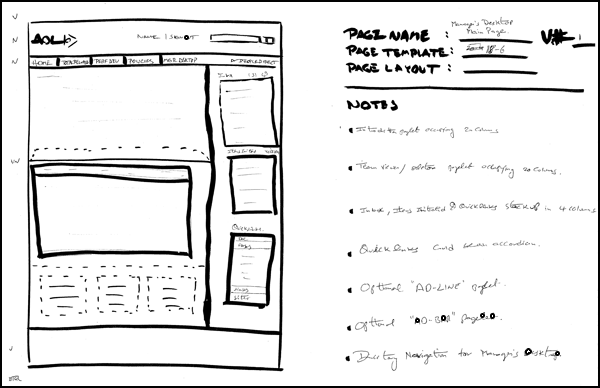Designing a Centralized, Role-Based Experience for Global HR Efficiency
Aol needed a Human Resources Portal that provided a seamless interface between the PeopleSoft HRIS system, contextual related employee and manager facing content. This portal provided top down communications as well as allowing employees to perform benefits elections, managerial transactions and corporate purchasing depending on their role and level of access.
Year
2007
Client
Aol
Overview
The AOL Human Resources Intranet Portal project was initiated to transform how employees and managers accessed and interacted with HR services. At the time, HR functions were fragmented across multiple systems, and the interface with the core PeopleSoft HRIS platform was outdated and difficult to use.
The goal was to create a seamless, centralized portal that integrated with PeopleSoft and delivered contextual, role-based experiences—making it easier for employees and managers to complete HR tasks such as benefits enrollment, approvals, and corporate purchasing, while improving overall efficiency and satisfaction.
The Problem
Before the redesign, HR processes were inefficient and inconsistent:
HR tools were scattered across disconnected systems, creating confusion and redundant effort.
PeopleSoft’s legacy interface made even simple actions (like updating personal data or approving requests) cumbersome.
Employees and managers lacked clarity on where to find information or complete tasks, leading to heavy reliance on HR staff for support.
These inefficiencies slowed down routine workflows, increased support requests, and reduced trust in HR’s digital systems. AOL needed a unified, intuitive solution that could serve diverse users—from individual contributors to executives—across global offices.
Discovery & Research
Key stakeholders included HR leadership, IT systems architects, internal communications, procurement, and regional HR representatives across domestic and international offices.
To align these groups, we conducted:
Stakeholder interviews and discovery workshops to identify business priorities and technical constraints
User interviews with employees and managers to surface pain points and workflow gaps
Task analysis and journey mapping to define critical user flows and identify friction points
We uncovered two primary issues:
Managers struggled to complete transactions (like promotions or requisitions) due to unclear pathways.
Employees had difficulty locating benefits information or completing self-service actions without HR assistance.
This research guided us toward a solution focused on clarity, contextual relevance, and task efficiency.
Design Process
Our approach included:
Role Mapping: Identified key user types—employees, managers, and executives—and the top tasks each needed to complete.
Role-Based Dashboards: Designed dynamic dashboards that surfaced the most relevant tools and content per user type.
Managers saw action items like approvals, team insights, and requisitions.
Employees accessed benefits, payroll, and performance tools directly.
Contextual Help: Embedded inline guidance within complex workflows (e.g., benefits changes or compensation adjustments).
Modular, Responsive Layout: Ensured a consistent experience across devices, from desktops to mobile.
Content Management System (CMS) Integration: Allowed HR and communications teams to surface announcements, policy updates, and deadlines in a flexible, unobtrusive way.
Accessibility and scalability were top priorities—our modular design allowed for regional customization without fragmenting the user experience.
The Solution
The resulting HR portal delivered a centralized, role-aware platform that unified PeopleSoft data with a modern, user-friendly interface.
Key outcomes of the design included:
Personalized dashboards tailored to user roles and permissions
Streamlined navigation and task flows for common HR actions
Integrated content delivery system for company-wide messaging
Localization features to address cultural and regional content needs
The portal became a one-stop destination for HR needs—empowering employees to self-serve and managers to act quickly and confidently.
Impact
Post-launch data and feedback revealed strong adoption and measurable improvement:
Reduced HR support tickets, as users could complete more tasks independently
Higher engagement with self-service tools and resources
Faster transaction completion rates, particularly for approvals and benefits changes
Positive stakeholder feedback, praising the portal’s intuitive design and minimal learning curve
By modernizing the HR experience without overhauling backend systems, the project delivered tangible efficiency gains and improved satisfaction across the organization.
Key Learnings
This project highlighted the importance of designing for clarity at scale—simplifying access and tailoring information based on role can transform how large organizations operate.
Key takeaways include:
Role-based design drives relevance: Surfacing only what’s essential reduces noise and speeds up decision-making.
Cross-functional collaboration is essential: Integrating legacy systems like PeopleSoft required close partnership between design, IT, and HR.
Localization matters: Accounting for cultural and regional differences improved adoption and usability across global offices.
Ultimately, the redesigned HR portal demonstrated how human-centered design can elevate complex enterprise systems, improving efficiency and employee experience simultaneously.




